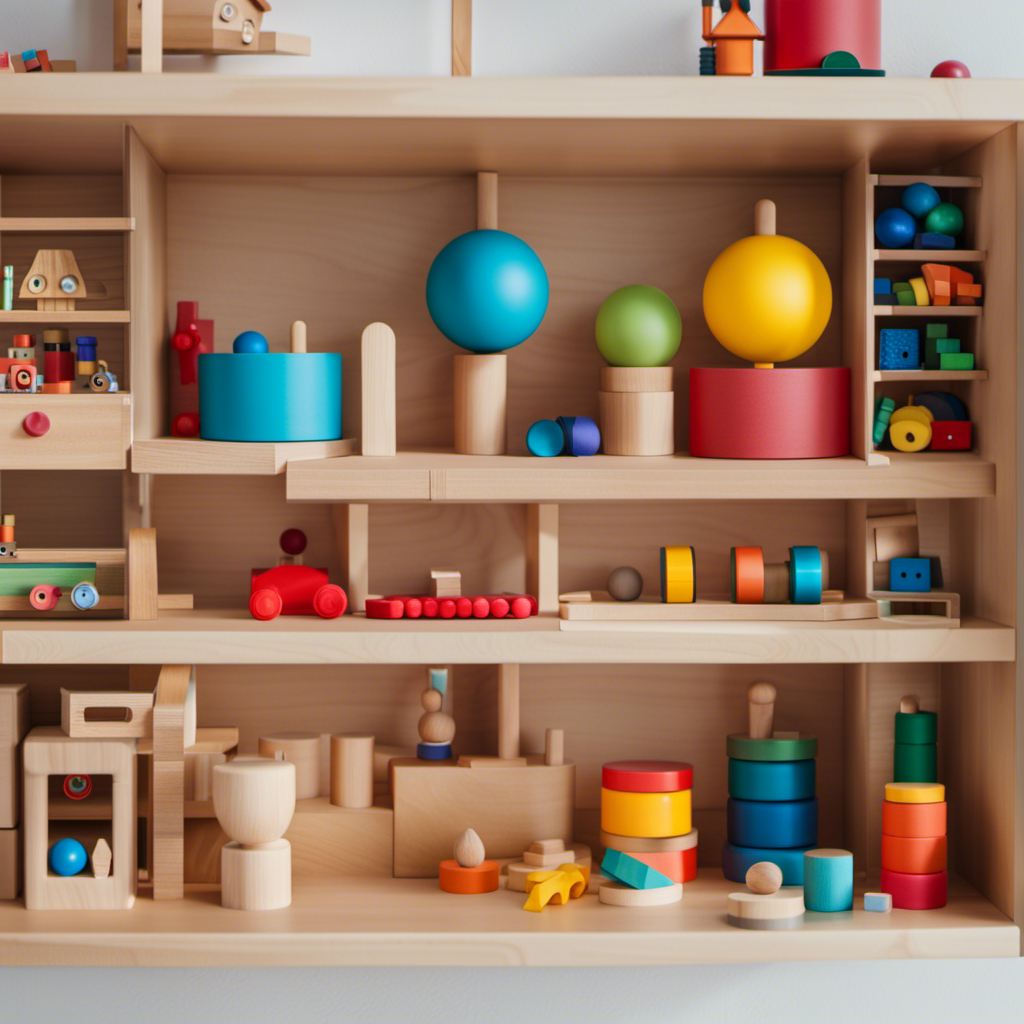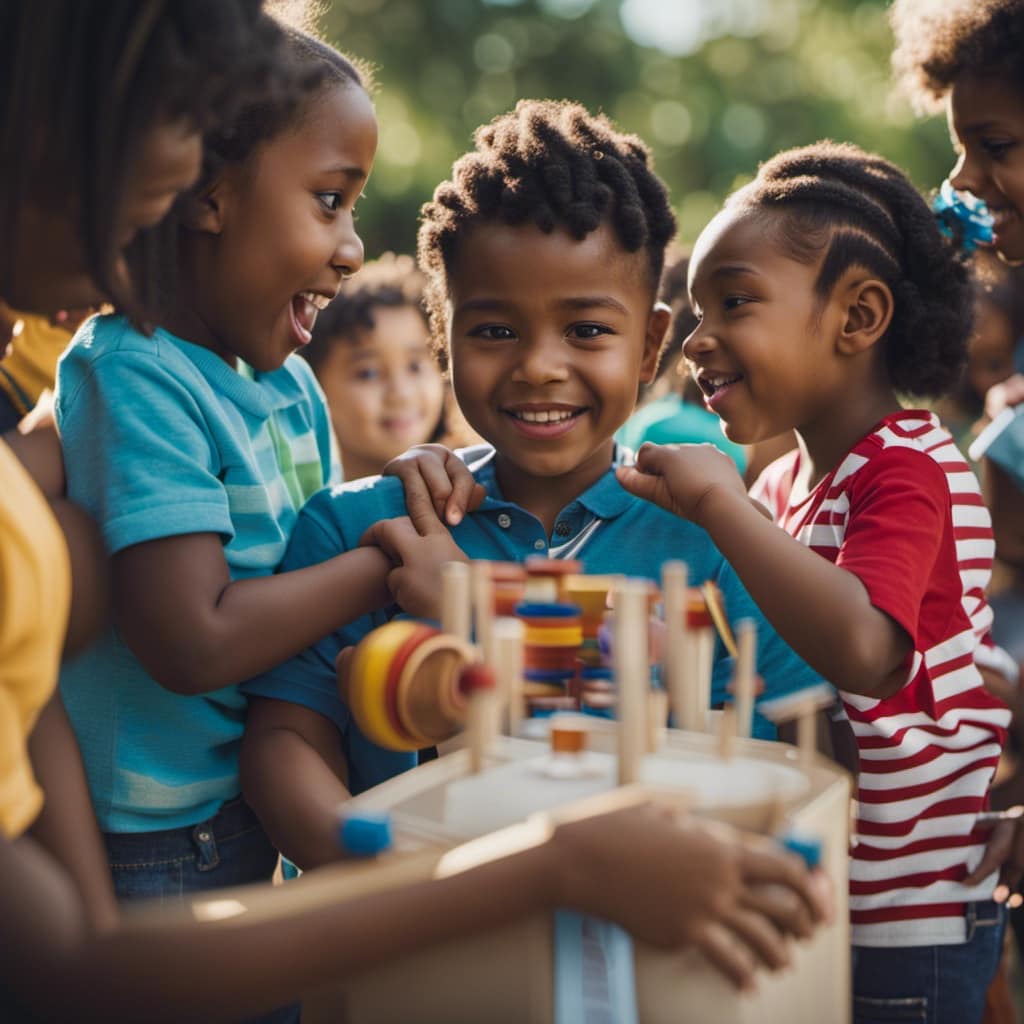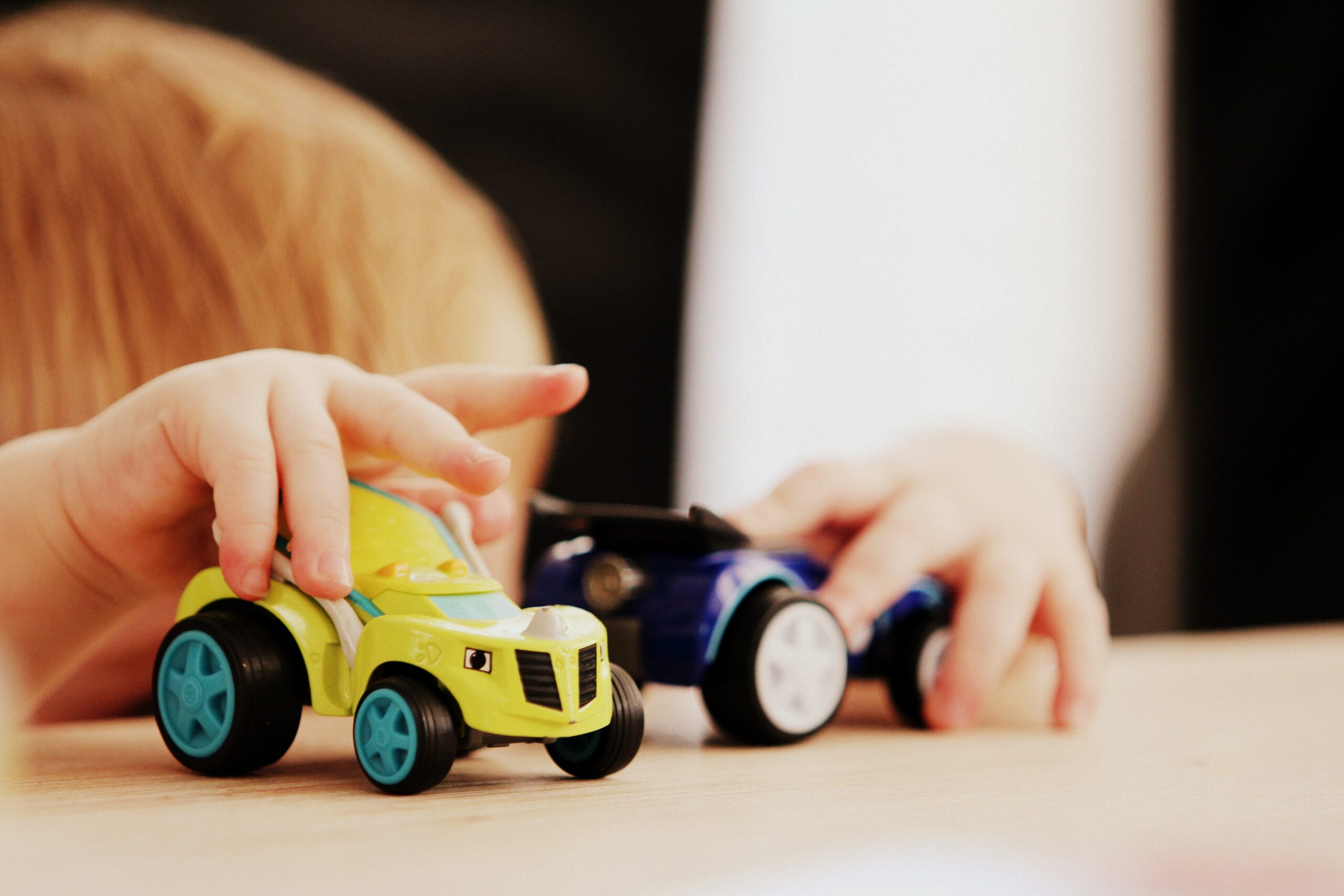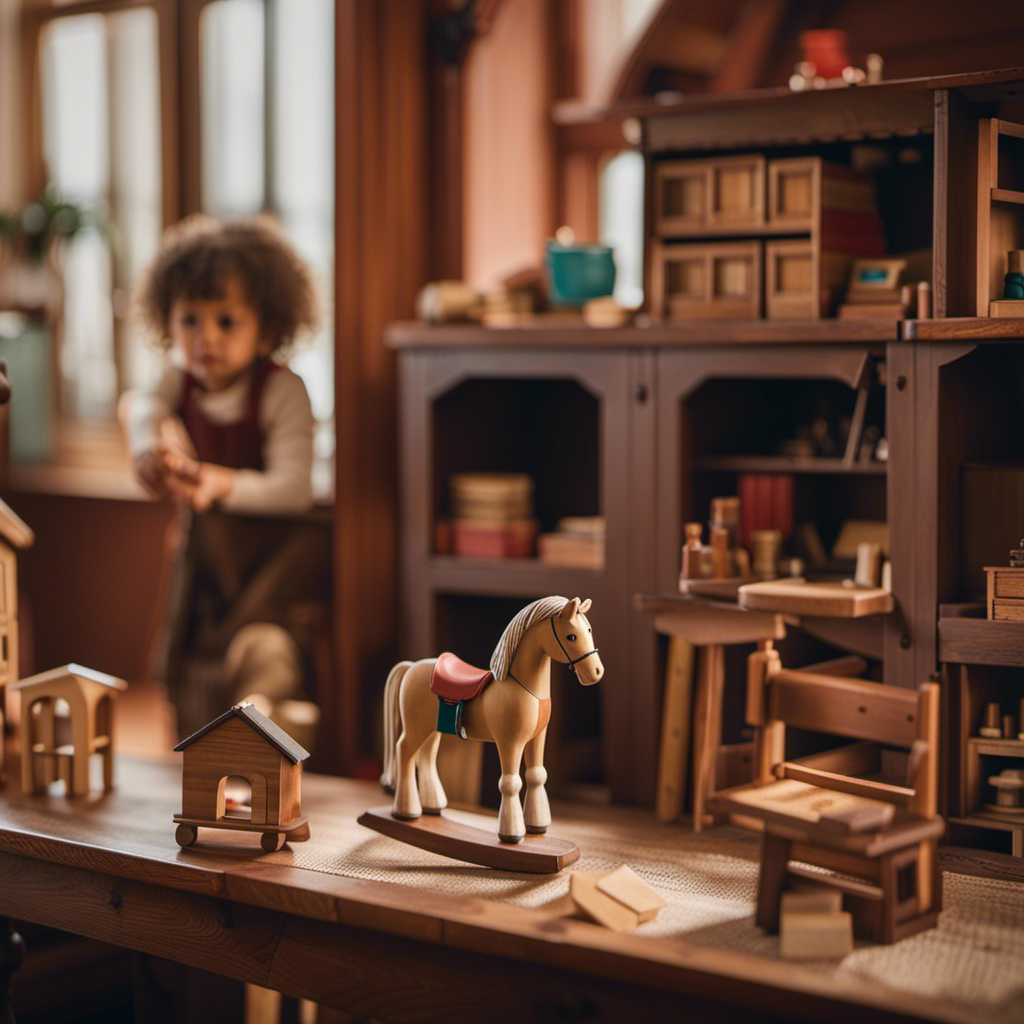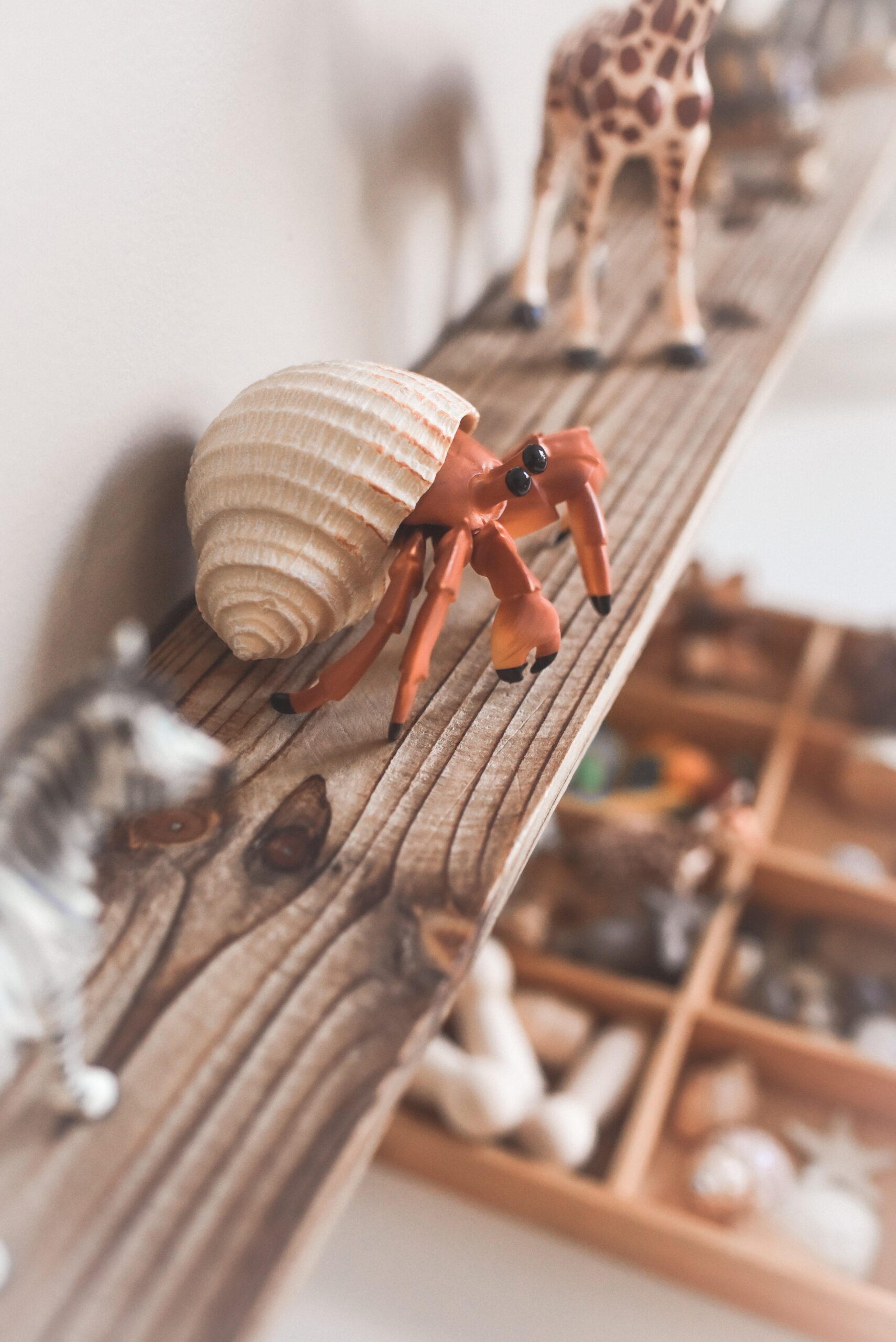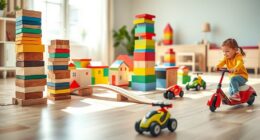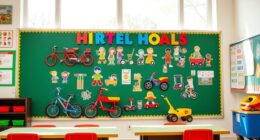Did you know that playing with Montessori toys can help stimulate cognitive, sensory, and physical development in babies?
In this article, I’ll show you how to make your own Montessori toys for babies, using materials you may already have at home.
From sensory bottles to tactile boards, these DIY toys are not only fun and engaging, but also designed to encourage independent play and learning.
So, let’s dive in and create some wonderful toys that will support your baby’s growth and exploration.
Key Takeaways
- Opt for natural materials such as wood, cotton, and natural fibers
- DIY sensory play ideas using household items are cost-effective and eco-friendly
- Montessori toys stimulate senses and promote learning through play
- Homemade sensory bins with different materials and shapes encourage exploration
Choosing the Right Materials
When making Montessori toys for babies, it’s important to choose the right materials. Sensory play is crucial for a baby’s development, as it helps them explore their surroundings and learn through touch, sight, and sound.
To create toys that engage their senses, opt for natural materials. Wood, cotton, and natural fibers are ideal choices as they are safe, non-toxic, and provide different textures for tactile exploration. Avoid plastic toys that may contain harmful chemicals.
Look for toys that offer contrasting colors to stimulate visual development and different shapes and sizes to encourage grasping and hand-eye coordination. By selecting natural materials for your Montessori toys, you are providing a safe and enriching environment for your baby’s sensory play.
Now, let’s move on to explore some specific examples of sensory toys for babies.
Sensory Toys for Babies
When it comes to choosing sensory toys for babies, safety is of utmost importance. It is crucial to ensure that the materials used in these toys are safe and non-toxic, as babies tend to explore with their mouths.
In addition to safety, sensory toys also offer a range of developmental benefits for babies. They stimulate their senses, promote fine motor skills, and encourage cognitive development.
If you’re looking for budget-friendly options, there are also plenty of DIY sensory toy ideas that you can easily make at home using simple materials.
Safe Materials for Sensory Toys
It’s important to choose safe materials for sensory toys when making Montessori toys for babies. Ensuring sensory toy safety is crucial for the well-being and development of our little ones. Here are four reasons why using non-toxic materials is essential:
-
Peace of mind: Non-toxic materials guarantee that your baby will not be exposed to harmful chemicals or substances, providing you with peace of mind.
-
Health and safety: Babies explore the world through their senses, often putting toys in their mouths. Using non-toxic materials ensures their health and safety during playtime.
-
Developmental benefits: Safe materials allow babies to engage in sensory exploration without the risk of adverse reactions, helping them develop their cognitive, motor, and sensory skills.
-
Environmentally friendly: Opting for non-toxic materials not only benefits your baby’s health but also contributes to a healthier environment.
Developmental Benefits of Sensory Toys
To help your child develop their cognitive, motor, and sensory skills, sensory toys offer a wide range of developmental benefits.
Sensory play benefits are not just about having fun; they play a crucial role in promoting cognitive development. When children engage in sensory play, their brains are stimulated, and connections between neurons are strengthened. This helps improve their problem-solving skills, memory, and attention span.
Sensory toys also enhance their fine and gross motor skills, as they manipulate objects of different shapes, sizes, and textures. Additionally, sensory play encourages exploration and creativity, as children use their senses to understand the world around them.
By incorporating sensory toys into your child’s playtime routine, you are providing them with a valuable learning experience.
Now, let’s explore some DIY sensory toy ideas to further enrich your child’s development.
DIY Sensory Toy Ideas
Try out these simple DIY sensory toy ideas to provide your child with engaging and educational playtime experiences. Here are four sensory play activities you can easily make at home with common household items:
-
Sensory Bottles: Fill empty plastic bottles with water, glitter, and small objects like beads or buttons. Secure the lids tightly and let your child shake and explore the different colors and textures.
-
Sensory Bags: Fill resealable plastic bags with hair gel, paint, or sand. Add small toys or objects for your child to discover as they squish and move the bag around.
-
Sensory Bin: Fill a large container with rice, beans, or even shredded paper. Hide small toys or objects for your child to find and play with using their hands or scoops.
-
Sensory Playdough: Make homemade playdough with flour, salt, water, and food coloring. Add scents like vanilla or lavender for an extra sensory experience.
These homemade baby toys will stimulate your child’s senses and promote learning through play. Now, let’s move on to DIY Montessori mobiles to continue your child’s developmental journey.
DIY Montessori Mobiles
As a parent, I’ve discovered the many benefits of incorporating Montessori principles into my child’s learning and development.
One key aspect is providing age-appropriate sensory stimulation. This allows them to explore and learn through their senses.
It’s also important to prioritize natural materials in their toys and activities. Natural materials provide a more authentic and tactile experience for children.
Benefits of Montessori
Did you know that Montessori toys can help your baby develop important skills like concentration and problem-solving?
Montessori toys are designed with sensory learning and hands-on exploration in mind, allowing babies to engage with their environment and learn through their senses. These toys provide opportunities for babies to explore different textures, shapes, and colors, stimulating their senses and encouraging their curiosity.
By engaging in hands-on play, babies develop their fine motor skills, hand-eye coordination, and spatial awareness. They also learn to problem-solve and concentrate as they manipulate the toys and discover how they work.
Montessori toys are not only fun for babies, but they also provide valuable learning experiences that promote their overall development.
Now, let’s explore age-appropriate sensory stimulation to further enhance your baby’s learning journey.
Age-Appropriate Sensory Stimulation
Are you aware of the importance of providing age-appropriate sensory stimulation for your little one’s development? It plays a vital role in their overall growth and learning.
Tactile exploration, in particular, is crucial for their cognitive and motor skills development. By engaging their sense of touch, babies learn about different textures, temperatures, and shapes. This helps them build their fine motor skills as they grasp, manipulate, and explore objects. It also enhances their sensory processing abilities.
To promote tactile exploration, you can provide them with various toys and materials that encourage touching and feeling. Incorporating items like soft fabrics, textured balls, and sensory bins filled with different materials can provide valuable sensory experiences for your baby. These activities not only stimulate their senses but also foster their curiosity and cognitive development.
Moving on to the next section, let’s discuss the importance of using natural materials in Montessori toys.
Importance of Natural Materials
Using natural materials in toys can provide a more sensory-rich experience for infants. Not only are these toys eco-friendly options, but they also offer numerous benefits for your baby’s development. Here are three examples of natural materials that can enhance your baby’s playtime:
-
Wood: Toys made from natural wood have a warm, earthy feel and a natural scent. They stimulate the senses and encourage exploration through touch and sound.
-
Fabric: Soft fabrics, such as organic cotton or bamboo, offer a gentle touch and can be used for cuddly toys or sensory blankets. Babies will enjoy the different textures and colors, stimulating their tactile and visual senses.
-
Natural Rubber: Toys made from natural rubber, like those used for teething, provide a safe and soothing option for babies. The soft texture is perfect for chewing and gumming, providing relief during teething.
By incorporating these natural materials into your baby’s toys, you are not only promoting a more sustainable and eco-friendly lifestyle, but also providing a sensory-rich experience that supports their development.
Now let’s move on to homemade teething toys…
Homemade Teething Toys
You can easily make homemade teething toys for your baby using safe and natural materials. Teething can be a challenging time for both babies and parents, but having the right toys can provide relief and comfort.
One option is to create homemade sensory blankets that have different textures and materials for your baby to explore. These blankets can be made using soft fabrics like cotton or fleece and can be customized with ribbons, buttons, and other safe attachments.
Another idea is to make DIY Montessori stacking toys using wooden blocks or cardboard tubes. These toys not only help with teething but also promote hand-eye coordination and fine motor skills. By incorporating natural materials and engaging textures, homemade teething toys can provide a sensory-rich experience for your baby.
Now, let’s move on to the next topic – the Montessori object permanence box, which is another valuable toy for your little one’s development.
Montessori Object Permanence Box
I’ve always been fascinated by the Montessori approach to early childhood development. One of the key materials used in this method is the Object Permanence Box. This box helps babies understand the concept of object permanence and provides numerous sensory development benefits.
If you’re interested in creating your own Montessori-inspired Object Permanence Box, there are plenty of DIY materials alternatives that you can use. Making it a fun and engaging learning tool for your little one.
Sensory Development Benefits
The sensory development benefits of Montessori toys for babies are numerous. These toys are designed to engage and stimulate a baby’s senses, promoting their cognitive and motor skills. Here are three key benefits of incorporating Montessori toys into your baby’s playtime:
-
Sensory Play Ideas: Montessori toys offer a variety of sensory experiences that help babies explore and understand the world around them. From different textures to vibrant colors, these toys provide opportunities for tactile, visual, and auditory stimulation.
-
Homemade Sensory Bins: Montessori toys often include sensory bins, which are containers filled with materials that encourage sensory exploration. Creating your own sensory bins at home allows you to customize the experience for your baby using items like rice, beans, or sand, along with objects of different shapes and sizes.
-
Development of Fine Motor Skills: Montessori toys are designed to promote the development of fine motor skills, such as grasping, pinching, and manipulating objects. By engaging in hands-on play with these toys, babies strengthen their hand-eye coordination and dexterity.
Incorporating Montessori toys into your baby’s playtime can have a positive impact on their sensory development. However, if you prefer to explore DIY materials alternatives, there are plenty of options available that can provide similar sensory experiences without the need for specialized toys or equipment.
DIY Materials Alternatives
Consider using household items like scarves, wooden spoons, and empty containers as alternatives to Montessori toys for sensory play with your baby. DIY sensory play ideas can be a great way to engage your little one’s senses and promote their development.
Not only are these alternatives cost-effective, but they are also eco-friendly materials alternatives. Scarves can be used for peek-a-boo games or for exploring different textures. Wooden spoons can be tapped together to create interesting sounds or used for sensory exploration by running them along different surfaces. Empty containers can be filled with various materials like rice, pasta, or beans for a fun sensory experience.
By using these simple household items, you can create engaging sensory play experiences for your baby without breaking the bank or harming the environment.
Now, let’s move on to Montessori puzzle balls.
Montessori Puzzle Balls
To make Montessori puzzle balls for your baby, gather fabric scraps and cut them into small squares. These DIY fabric balls are a great Montessori stacking toy that will engage your baby’s senses and help develop their fine motor skills.
Here’s how you can create these colorful and tactile toys:
- Cut fabric scraps into small squares, around 3 inches in size.
- Fold each square in half diagonally to create a triangle.
- Place a small bell or jingle bell in the center of the triangle.
- Fold the fabric in half again, enclosing the bell securely.
- Tie a knot at the top, leaving a loop for easy grasping.
These puzzle balls provide a wonderful sensory experience for your baby as they explore different textures and sounds.
Now, let’s move on to Montessori treasure baskets, which offer a wide variety of stimulating objects for your little one to discover and explore.
Montessori Treasure Baskets
Now, let’s explore Montessori treasure baskets, which offer a wide variety of stimulating objects for your little one to discover and explore. These sensory play baskets are filled with open-ended toys that encourage your baby’s curiosity and exploration.
The idea behind these baskets is to provide a collection of items that engage your baby’s senses and promote their cognitive development. From different textures like soft fabrics and wooden toys to objects that make sound or have different shapes, these treasure baskets offer a rich sensory experience for your little one.
As they reach in and explore each item, they are developing their fine motor skills, hand-eye coordination, and problem-solving abilities.
DIY Montessori Shape Sorters
Let’s explore how you can create your own Montessori shape sorters to support your child’s cognitive development.
DIY Montessori stacking toys are a great way to engage your little one in hands-on learning. By making these toys yourself, you can customize them to meet your child’s specific needs and interests.
Start by gathering materials such as wooden blocks, different shaped containers, and non-toxic paint. Paint each block a different color and let them dry. Then, cut corresponding shapes in the lids of the containers.
Your child can then match the blocks to the corresponding shape and drop them in. This activity helps develop their fine motor skills, shape recognition, and problem-solving abilities.
Now, let’s move on to Montessori sensory bags and how they can enhance your child’s sensory exploration and creativity.
Montessori Sensory Bottles
After exploring DIY Montessori shape sorters, let’s move on to another engaging toy for babies: Montessori sensory bottles. Sensory bottles are not only captivating for infants but also provide numerous benefits for their development. Here are three alternatives to traditional sensory bottles that you can easily make at home:
-
Discovery Bottles: Fill a clear plastic bottle with a variety of materials like rice, beads, or feathers. Babies will enjoy shaking and watching the objects move inside.
-
Nature Bottles: Collect small natural items such as leaves, flowers, or pebbles and place them in a bottle filled with water. This will create a calming visual and auditory experience for your little one.
-
Sound Bottles: Fill different bottles with materials that make distinct sounds, such as bells, marbles, or sand. Babies will be fascinated by the different noises produced.
Sensory bottles offer sensory stimulation, promote focus and concentration, and enhance hand-eye coordination. Now, let’s move on to the next section about homemade Montessori rattles.
Transitioning to the subsequent section on ‘homemade Montessori rattles,’
Homemade Montessori Rattles
You can easily create engaging rattles using everyday household items. Homemade Montessori rattles are a wonderful way to stimulate your baby’s senses and promote their development.
To make these rattles, gather items like empty water bottles, dried beans or rice, and colorful ribbons. Fill the water bottles with the beans or rice, and secure the cap tightly. Attach the ribbons to the neck of the bottle, creating a fun and visually appealing toy for your little one.
These homemade Montessori rattles provide auditory, visual, and tactile stimulation, promoting your baby’s sensory development. Alongside homemade Montessori stacking toys and Montessori sensory play mats, these rattles are a great addition to your baby’s playtime.
Now, let’s move on to Montessori tactile boards, which offer even more opportunities for sensory exploration.
Montessori Tactile Boards
After exploring homemade Montessori rattles, let’s move on to another engaging DIY Montessori toy: the Montessori tactile board. Tactile play is crucial for babies’ development, as it stimulates their sense of touch and helps enhance their fine motor skills.
A Montessori tactile board is a simple yet effective toy that provides various textures for babies to explore. You can easily create one at home using different materials such as sandpaper, fabric, cotton balls, and even natural materials like leaves or pinecones. Simply attach these materials to a sturdy board and let your little one explore the different textures with their hands.
To emphasize the importance of tactile play and its benefits for fine motor skills, here’s a table highlighting the various textures you can incorporate into a Montessori tactile board:
| Texture | Benefits | Examples |
|---|---|---|
| Sandpaper | Develops sensory perception | Fine-grit sandpaper |
| Fabric | Enhances tactile sensitivity | Soft cotton fabric |
| Cotton Balls | Stimulates finger dexterity | Fluffy cotton balls |
| Natural Materials | Connects with nature | Leaves, pinecones |
Creating a Montessori tactile board not only provides a fun and engaging activity for your baby but also supports their sensory and motor development.
Frequently Asked Questions
How Can I Ensure the Safety of the Materials Used in Homemade Montessori Toys for Babies?
To ensure the safety of materials used in homemade Montessori toys for babies, I prioritize safety considerations. I carefully choose materials that are non-toxic and free of small parts that could be choking hazards.
I also consider material alternatives, such as using natural wood instead of plastic.
It’s important to regularly inspect the toys for any signs of wear or damage to ensure continued safety.
Are There Any Specific Age Recommendations for the Different Types of Montessori Toys Mentioned?
When it comes to Montessori toys, specific age recommendations are crucial. Different types of toys cater to different developmental stages, ensuring optimal learning and engagement.
It’s important to choose toys that are appropriate for your baby’s age and abilities. This will help them to develop important skills like fine motor coordination and problem-solving.
Can I Use Alternative Materials for Making Montessori Toys if I Don’t Have Access to the Ones Mentioned in the Article?
If you don’t have access to the materials mentioned in the article, you can definitely use alternative materials to make Montessori toys.
There are many creative DIY Montessori toy ideas out there that you can explore.
Look for safe and natural materials like wood, fabric, or even recycled objects that can be repurposed.
Just make sure to consider the age appropriateness and safety of the materials you choose.
Are There Any Specific Techniques for Assembling the Montessori Mobiles Mentioned in the Article?
Assembling Montessori mobiles can be a bit tricky, but with the right techniques, it can be a breeze.
One important tip is to make sure you have all the materials needed before starting.
Start by attaching the different elements to the mobile frame, making sure they hang at different heights.
Then, use a sturdy string or ribbon to hang the mobile from the ceiling or a crib. Remember to adjust the height to match your baby’s reach.
These techniques will ensure a stimulating and engaging experience for your little one.
How Can I Clean and Sanitize Homemade Montessori Toys to Ensure They Are Safe for My Baby to Play With?
To clean and sanitize homemade Montessori toys, there are a few techniques and materials you can use.
First, check the toy’s materials to ensure they can withstand cleaning.
For wooden toys, a mixture of vinegar and water works well.
For fabric toys, machine wash them on a gentle cycle with mild detergent.
Plastic toys can be soaked in a solution of bleach and water.
Remember to rinse all toys thoroughly and let them air dry completely before giving them to your baby to play with.
Conclusion
In conclusion, making Montessori toys for babies isn’t just practical and cost-effective, but it also lets you customize the toys to meet your baby’s specific needs and developmental stage.
By using safe and natural materials, you can create sensory toys, mobiles, teething toys, and other interactive objects. These toys will engage and stimulate your baby’s senses, promoting their learning and development.
So why wait? Start crafting your own Montessori toys today and witness your baby’s curiosity and joy unfold before your eyes.
Tina is the heart and soul behind Toddler Ride On Toys. With a passion for early childhood education and a deep understanding of child development, Tina ensures that every piece of content on our website reflects our commitment to playful learning. Her expertise in Montessori, Preschool, STEM, and Waldorf education philosophies helps shape our website into a valuable resource for parents, caregivers, and educators.

